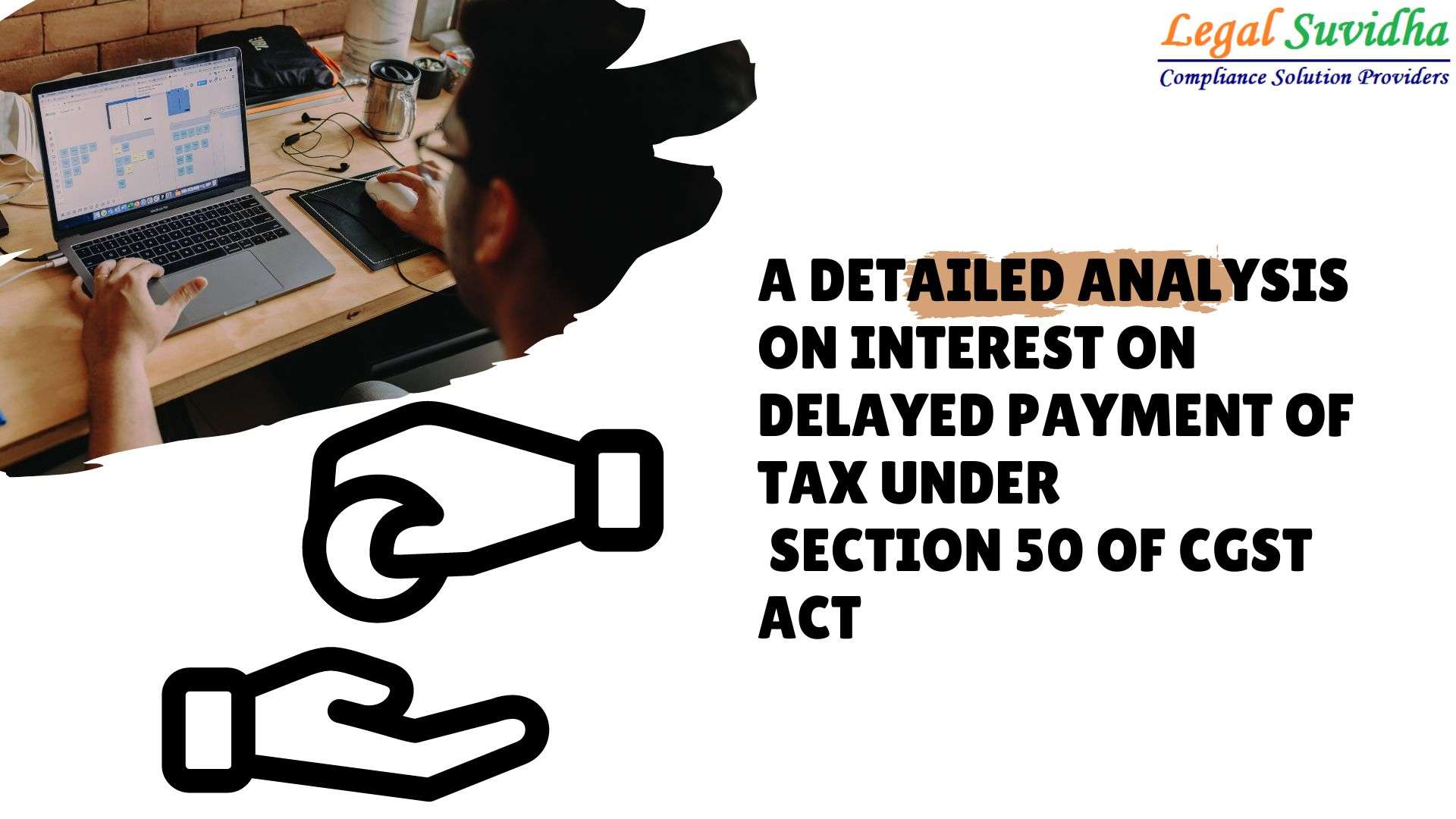SECTION 50 OF CGST ACT: INTEREST ON DELAYED PAYMENT OF TAX
The Government of India has specified the due dates to pay Goods and Services Tax. The due date to pay GST is different for different types of taxpayers. If one fails to pay GST within the due date, one must pay the interest along with the GST dues for the delay period.
When is Interest levied under GST law?
According to section 50(1) of the Central Goods and Services Tax (CGST) Act 2017, the taxpayer should pay interest on GST liability if the following instances:
- Fails to pay such GST within the period as stipulated above
- Makes short payment for the GST
Interest is paid on GST liability deposited late on the unpaid tax at 18% p.a. for the period on the tax amount or any part that remains unpaid.
Further, an assessee who makes:
- Delay in depositing GST
- Makes short payment of GST
- Claims ITC wrongly
- Claims ITC over what they are eligible for
- Reduces GST liability wrongly or more than what they were eligible for
would have to pay interest on such excessive or wrongful claim or such excessive or wrongful reduction at the rate of 24% p.a. for the wrongly utilised input tax credit or on the difference in output tax liability. Interest gets charged and becomes payable if the taxpayer delays paying GST liability within the due date. CGST Act is calculated from the day succeeding the due date till the day such dues are paid.
What is the interest rate for late payment of GST?
Interest at 18% p.a. would be applicable for late payment of GST. If the authorities find that the assessee misstated output tax liability in its GST return, then interest at 24% p.a would be applicable. With interest, a penalty can be levied on the assessee under GST for erroneous return filing, fraud or wilful misstatement.
How is interest calculated with examples?
Previously, the interest on the late tax payments was charged on a gross basis, which implies that interest was charged on the gross tax amount without giving the effect of the ITC. Relaxation through a proviso was inserted to ease this hardship felt by an assessee.
According to Central Tax Notification No. 16/2021, interest would be applied to the net cash tax liability in case of delayed GST payment.
Net cash liability = Gross GST liability – input tax credit,
However, a taxpayer against whom a proceeding is an underway for:
GST not paid or short paid or wrongly availed ITC or generated refund wrongly for any reason other than fraud,
GST not paid or tax paid or short paid or availed ITC or generated refund wrongly for the sole purpose of evading tax,
would have to pay interest on ‘Gross GST Liability’.
Example – 1
ABC Ltd has to pay the GST of INR 40 lakhs on or before 20th June 2022. However, the company discharged its tax liability on 20th July 2022. The interest on GST that ABC Ltd. Needs to pay will be:
Interest rate – 18%
Days in default – 30 days
Outstanding tax – Rs.20 lakh
The interest on delayed payment of GST would be INR 59,178/- (40 lakh*18%*30/365).
Interest in the delay of GST Refund
The Indian Supreme Court held that if there’s a delay in processing the GST refund, a 6% interest needs to be paid by the department to the assessee, provided such delay is inordinate.
This ruling comes after the Indian Government filed an appeal in the Supreme Court against a verdict of the Gujarat High Court requiring the department to pay interest on the delayed refund at 9%, where the delay was between 94-290 days.
Interest levy in the GST portal
The details for late fees and Interest for the previous tax period are calculated and auto-populated as per the values declared in the previous period. If the taxpayer wants to add or modify the auto-populated details of the late fee and interest payable, perform the following steps:
Step 1. Click 5.1 on the “Interest and Late fee” for the previous period tile.
Step 2. The taxpayer must select the checkbox for a declaration if the taxpayer wishes to declare the interest liability.
The system would calculate the interest values and auto-populate based on the tax-period-wise breakup of tax liability declared in the previous return period. The system would also calculate the late fee depending on the days exceeding the filing due date for the previous return period.
The taxpayer then needs to click the ‘System Generated GSTR-3B’ button, as shown in the image below, to view and download the pending liability breakup.
Note: The taxpayer can also view the turnover details of the GSTIN by clicking on the ‘View Your Turnover’ button
Step 3. The taxpayer then needs to click on ‘Confirm’ button to proceed to file GSTR-3B as shown below.
Note: If the taxpayer has made any downward changes to the auto-populated interest values, then such fields will be highlighted in red and a warning message would be displayed. The taxpayer can check the system-calculated amount and amount entered by the taxpayer by hovering over the box.
Step 4. The taxpayer would be directed to the landing page of the GSTR-3B, and the late fee and interest for the previous period tile in Form GSTR-3B would reflect the total value of Integrated Tax, State/UT Tax, Central Tax and Cess of the previous period.
Note: The taxpayers are advised to click the ‘Save GSTR-3B’ button at the bottom to save the data in the GST system if they want to exit at this stage and finish the filing later.
Rate of interest:
The government has notified the rate of interest under section 50 of the act and section 20 of the IGST act vide notification No. 13/2017 – Central Tax and Notification No. 6/2017 – Integrated Tax Dated 28-06-2017 and amended from time to time. Accordingly, 18 % per annum rate of interest has been notified for the section u/s 50(1) and 24 % for section 50(3) of the act.




















